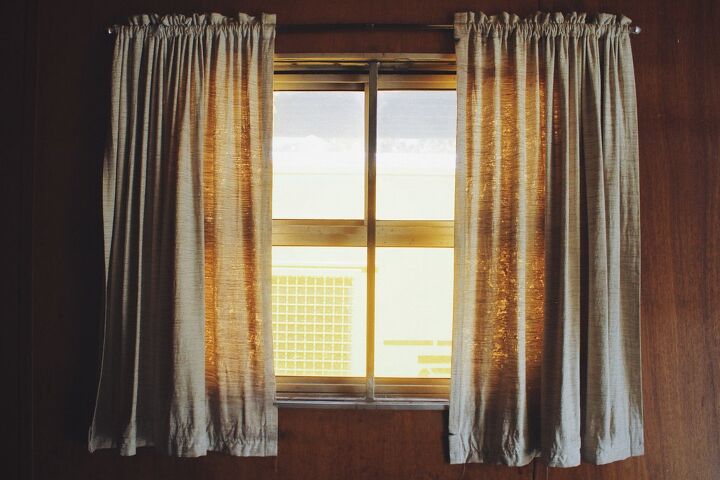7 Types Of Curtain Tops (With Photos)

Although window treatments are often chosen for privacy, drapes are an excellent way to add a nice touch of color and pattern to your living spaces. Whether you opt for a bright hue to add bold contrast, a darker color than your walls to visually expand the space, or an energetic pattern to liven up the room, fabric window treatments are a surefire way to infuse style.
Though, when it comes to choosing curtains or drapes, it’s important that you are aware of all your options. With numerous options available, choosing a curtain top or drapery style for your home can be very overwhelming. Some of the many types of curtain tops include rod pocket, grommet, tab top, and numerous variations of pleats.
That said, the following are the most popular curtain tops and drapery styles to help you decide which is best for your home.
What is a Curtain Top?
Also referred to as a curtain or drapery heading, curtain tops refer to the top piece of the curtain that is either attached to a track or curtain rod. The curtain top that you choose can have a drastic impact on the overall look of your curtains and will also play a role in the type of rod or track that you can use.
Types of Curtain Tops
Now that you know exactly what a curtain top is, let’s take a look at some of the most common options out there when it comes to choosing the right drapery style.
1. Rod Pocket (Pole Pocket)
As the name suggests, the rod pocket style features a pocket that is sewn across the top of the curtain panel through which the curtain rod is inserted. The pocket itself can accommodate a two-inch diameter pole. This style is easy to install as the curtain rod simply slips into the channel. These types of panels are typically made of lightweight fabrics and often unlined to offer a more casual look.
The more fabric that is squeezed onto the rod, the more dramatic the fabric bunching will be. Most rod pocket curtain panels feature a ruffled header. While this option is not as popular as those that are straight-topped, the ruffles offer a more formal, traditional look that some homeowners prefer.
This style is designed for stationary curtain panels only and is not intended to traverse. The panels are usually kept in a closed position or held back using decorative tiebacks.
2. Grommet (Eyelet)
Grommet curtains, also referred to as eyelet or ringed curtains, feature a very simple, casual design that has been popular for quite some time. These types of curtain panels hang from grommets that are either attached to the top of the panel or incorporated into the fabric near the top edge. Instead of being hidden inside of a pocket, the curtain rod is exposed. For this reason, it is very common to choose an appealing metal or wooden rod that has decorative finials on either end.
It’s also recommended that you coordinate the finish of the grommets with the other metals in the space – including the rod itself and all the hardware. You can find grommet curtain tops in various finishes, including black, chrome, polished brass, satin nickel, antique brass, and much more. Depending on the color, pattern, and fabric of the curtain that you choose, this style of drapery can work with virtually any decorating style – from sleek, contemporary to casual country.
Since this type of window treatment is very easy to open and close, it works great for patio windows or any other windows that need to be accessible. It’s important to note that, with this drapery style, the fabric measures one inch above the actual rod because of the grommet inlay in the fabric.
3. Tab Top Curtains
With tab top curtains, the top of the panel is outfitted with a row of fabric tabs, or loops, at consistent intervals. The curtain rod is inserted into the loops, which the panel will hang flat from. As such, this drapery style is a wonderful way to display unique fabric prints and patterns.
These curtains work especially well with more casual décor styles, including cottage, country, and shabby chic. It’s important to note that tab-top curtain panels are usually stationary, as they can be a bit of a nuisance to draw across the rod. Occasional hand traversing is fine, but this drapery style is best suited for windows that won’t be opened on a regular basis.
Another variation of the tab top curtain is known as the wrapped or gathered tab style. This style features a decorative sleeve around each tab that, in some cases, may be in a contrasting color. Since these tabs are installed tightly around the curtain rod, they are designed only for stationary panels.
4. Pleated Curtain Tops
Pleated curtain tops are a classic drapery style that has yet to go out of fashion, despite their popularity rising and falling with current design trends. Since the pleats have a formal look, they tend to work best with traditional or more formal décor styles. The pleats at the top of the curtains are created with header tape that, if you want to sew your window treatments yourself, you can purchase by the yard at fabric stores.
They are sewn from the back of the panel and when pulled together, the tape forms the pleats in the fabric. Hanging hooks are then inserted into the tape, and the curtains panels either traverse rods or are hung on rings. They use a cord-and-pulley system in order to open and close the curtains. There are countless styles of pleats to choose from, each of which are sewn into the top edge of the panel to yield a unique, decorative header.
- Pinch Pleat: This is the most common pleat style, and is typically considered the most traditional as well. It is created by gathering equally spaced single, double, or triple folds and then pinching them together in the center. This results in fans forming above and below the pinch.
- Goblet Pleat: The goblet pleat is a form of triple-pinch pleat that gets its name because it resembles a goblet. It gets its wine glass shape because the pleating of the pinch is embellished using stiffening paper or a card. This type of pleat is best suited for curtains with a long drop. It is formal and sophistication, making it a wonderful option for grand settings.
- Pencil Pleat: Another common pleat style, the pencil pleat offers a simple and casual look. These types of curtains feature thin, single pleats that are displayed in neat, stiff folds. Pencil pleat is ideal for fabrics that aren’t too thick.
- Inverted Pleat: Inverted pleat is similar to the traditional pinch pleat style, with the only difference being that the fabric is pinched at the top of the header instead of the middle. This style is not recommended for frequent opening and closing, and is best suited for decorative purposes only.
- Box Pleat: For a more modern style pleat, the box pleat is the way to go. The fabric is folded into pleats on both the front and the back of the panel, yielding flat, box-like folds. The clean, simple lines that are created will work well with any modern or contemporary décor style.
- Cartridge Pleat: Cartridge pleats feature single pleats that are spaced more widely than conventional pinch pleats. They also differ because they are rounded at the top of the panel.
- Tuxedo Pleat: Tuxedo pleats feature larger pleats and are typically hung on a decorative curtain rod to add formal and contemporary style.
5. Flat Panel Top
Another curtain top option, flat panel draperies can work well with virtually any décor style. They have a simple, yet elegant look that is stiffened using buckram and then attached to decorative curtain rods with ring clips.
6. Flowing Style
Flowing style curtain tops feature droopy pleats that are attached to the rod using ring clips. You can adjust the natural sag of the fabric by adding or subtracting ring clips. More rings will result in smaller droops, while fewer rings will cause larger droops.
7. Tie- Top Curtains
This type of curtain top consists of the curtains being attached to the rod by tying knots or bows at the top. As such, they are only designed for stationary panels. The style is excellent for those looking to achieve a romantic, bohemian, or just generally laidback ambiance in their living space.
Related Questions
What hooks do you need with pinch pleat curtains?
Pinch pleat curtains, whether they’re double or triple pleated, can either hang on a track or a rod with rings. Regardless of the system you choose, each uses the same type of hook to connect to the track or rod. The type of hooks that you choose can be those that slip in next to the pleats or feature a spike that must be pierced through the pleat from the back.
What is a Buckram heading?
A Buckram heading is a strip of translucent or white stiffener that is used to create a more defined shape on a curtain top.
Related Guides

Jessica considers herself a home improvement and design enthusiast. She grew up surrounded by constant home improvement projects and owes most of what she knows to helping her dad renovate her childhood home. Being a Los Angeles resident, Jessica spends a lot of her time looking for her next DIY project and sharing her love for home design.
More by Jessica Stone

































